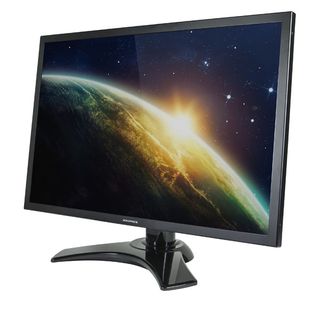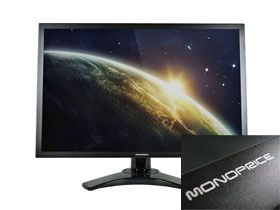Early Verdict
Pros: Low price, all-metal chassis, decent image quality with proper adjustment, Adobe RGB gamut Cons: Poor out-of-box accuracy, no sRGB gamut preset, middling contrast Verdict: A 30-inch 16:10 monitor is a rare bird these days, and as such, another brand will cost you at least $1000. If you need a wide-gamut screen, the Monoprice 30-inch IPS LED is one of the cheapest regardless of size. With a little tweaking, it delivers a good image and correspondingly good value.
Pros
- +
Low price, all-metal chassis, decent image quality with proper adjustment, Adobe RGB gamut
Cons
- -
Poor out-of-box accuracy, no sRGB gamut preset, middling contrast
Why you can trust Tom's Hardware
Monoprice 30-inch IPS LED Monitor Review
No matter what monitors we review, a great many of your comments focus on price. We try to test high-end models in an effort to report on the latest advances in display technologies, and so the more budget-friendly products sometimes receive less coverage.

If you look beyond the offerings from major manufacturers, however, there are some good deals to be found online. Unfortunately, it’s much more difficult for us to get our hands on those screens because they often come and go before we have a chance to test them. In 2013, we managed to get an Auria EQ267W in the lab and found it be good-performing monitor at an unbeatable price. If you’re in the market for a 27-inch QHD/IPS screen, they are still available. And of course, gamers will want to check out Overlord’s Tempest X270OC, another 27-inch IPS that runs at up to 120Hz.
Today we’re checking out a unique offering from Monoprice, the 30-inch IPS LED. Yes, that’s really its name. There's no alphabet soup to mess with. And here’s the best part: it sports a 16:10 aspect ratio. We’ve long lamented how rare this screen size has become, and we’re glad to see you can buy one in a jumbo size for such a low price.
Known merely as “Product 10734” the 30-inch IPS LED is listed (as I write this) for $689.33 at Monoprice.com. Considering the competition is both low in quantity and higher in price, it’s a steal for a monitor this big (especially one with a 16:10 aspect ratio).
Looking at our most recent reviews, the only other screen in its class is the BenQ BL3200PT, a 32-inch VA-based panel with 2560x1440 resolution and super-high contrast. But that one sports a 16:9 aspect ratio and offers only the sRGB color gamut. To find a closer match to the Monoprice, we had to go all the way back to June 2013 when we reviewed 30-inch 16:10 panels from HP and DoubleSight. The HP has since been replaced by a newer model, while you can still buy a DS-309W for around $1100.
You probably won't want to, though. The Monoprice one-ups both competitors with the addition of a GB-r-LED backlight. The HP and DoubleSight use CCFL. Not only is the LED more energy-efficient, but it enables the wider Adobe RGB gamut. This is not something Monoprice mentions in its description; we discovered it during testing.
So we have a solidly-built 30-inch 16:10 jumbo screen at a low price. But does it perform well? We found a few quirks during our evaluation, but with careful adjustment (which we’ll show you how to do expense-free), you can get a decent image and save about $400 over the DoubleSight. Let’s take a look.
Current page: Monoprice 30-inch IPS LED Monitor Review
Next Page Packaging, Physical Layout, And Accessories
Christian Eberle is a Contributing Editor for Tom's Hardware US. He's a veteran reviewer of A/V equipment, specializing in monitors. Christian began his obsession with tech when he built his first PC in 1991, a 286 running DOS 3.0 at a blazing 12MHz. In 2006, he undertook training from the Imaging Science Foundation in video calibration and testing and thus started a passion for precise imaging that persists to this day. He is also a professional musician with a degree from the New England Conservatory as a classical bassoonist which he used to good effect as a performer with the West Point Army Band from 1987 to 2013. He enjoys watching movies and listening to high-end audio in his custom-built home theater and can be seen riding trails near his home on a race-ready ICE VTX recumbent trike. Christian enjoys the endless summer in Florida where he lives with his wife and Chihuahua and plays with orchestras around the state.
-
MxMatrix I saw an ASUS UHD PB279Q (ips panel) for roughly the same price.Reply
So I'm not even going to bother for 30" if its possible to get UHD. -
mitch074 I really wonder why Tom's never evaluates Iiyama screens - the ProLite XB2776QS is a 27" 2560x1440 IPS screen, available at the time for $450 with a zero pixel defect, 3 years on-site replacement warranty, sRGB factory-calibrated profile that does work... And it came out in 2013. I own one, and although its reliability initially left much to be desired (3 replacements for defects : one light leak, one dead subpixel, one power issue), it was replaced every time in less than 72 hours by Iiyama - and yes, including once when I picked up one dead (black) subpixel. It has since been replaced by a model with the very same specifications and prices, but more reliable electronics.Reply -
nekromobo Why wouldn't a 34" 800$ IPS 21:9 (Dell U3415W) compete with this or the other similar displays. Also the external power brick is big nono unfortunely :(Reply -
Karsten75 It seems Overlord isn't selling any more monitors, so I guess references to Overlord monitors should be removed?Reply -
achoo2 With all the "though this feature is not described on the website" items and my unfamiliarity with the brand, I'd be reluctant to buy this monitor for fear that my device wouldn't match the review sample.Reply -
DisplayJunkie As much as we all love Monoprice for their excellent pricing and quality on things like cables, this display is another catastrophic failure, or more likely an attempt to pander to the uninformed:Reply
- no backlight control. Right out of the gate, the display is useless. How can they fail so badly at the most basic and crucial aspect of a monitor? This is an exact repeat of the Zero-G by the way.
- contrast sucks and attempting to control backlight level makes it even worse. Again same as the Zero-G.
- Adobe RGB accuracy is not even good enough even for amateur photo/print work (and that's *after* calibration with a $250 device!), and no sRGB mode means the display is useless for everyone else / every other usage scenario
All I see is pandering to the uninformed, trying to sell poorly implemented panels to those who are impressed by the large size and resolution.
If it had a functional backlight control and cost maybe $500 max then it would be worth considering. -
bit_user Something I've always wondered about Monoprice is whether they actually: a) design anything themselves, b) produce specifications and select bids from manufacturers, or c) just import products that (usually Chinese) companies are already making.Reply
Can someone please clarify?
-
DarkSable Reply15244178 said:I really wonder why Tom's never evaluates Iiyama screens - the ProLite XB2776QS is a 27" 2560x1440 IPS screen, available at the time for $450 with a zero pixel defect, 3 years on-site replacement warranty, sRGB factory-calibrated profile that does work... And it came out in 2013. I own one, and although its reliability initially left much to be desired (3 replacements for defects : one light leak, one dead subpixel, one power issue), it was replaced every time in less than 72 hours by Iiyama - and yes, including once when I picked up one dead (black) subpixel. It has since been replaced by a model with the very same specifications and prices, but more reliable electronics.
I've got one of those too, but because the model I ordered wasn't available in my region, they've never supported me... instead trying to get me to communicate with a german company that offers no warranty.
While iiyama monitors are very good, I've noticed that they almost all share two issues:
1) coil whine from the power subsystem. Every single iiyama I've owned either has cheap caps or just not enough insulation, and has audible coil whine even when off.
2) Poor support for low brightness. This is actually a really annoying one for me - iiyama monitors are bright and don't have enough support on the low end; even at its lowest brightness setting with contrast down just above where it would drive me crazy, my iiyama is still brighter than any other monitor I've had.

